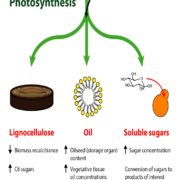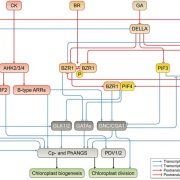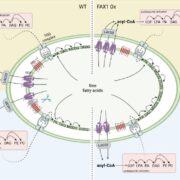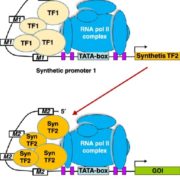A synthetic switch based on orange carotenoid protein to control blue-green light responses in chloroplasts (Plant Physiol)
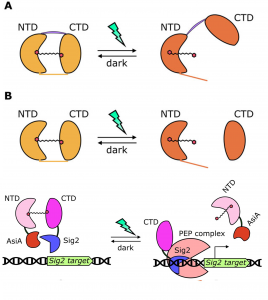 Synthetic biology aims to engineer and redesign components of natural organisms for useful purposes. One of the most prolific areas of synthetic biology is based on the engineering of photoreactive proteins with signaling potential, such as photoreceptors. Natural photoreceptors consist of a prosthetic chromophore which is responsible for light perception, and an apoprotein, which transduces the light signal. To expand beyond the natural existing photoreceptors, researchers have been developing synthetic ones by interchanging interesting protein domains. In this work, Piccinini et al. developed a light-dependent, chloroplast localized photoswitch system based on cyanobacterial Orange Carotenoid Proteins (OCPs), which use a keto-carotenoid as a chromophore. OCPs have distinct N- and C- terminal domains (NTD and CTD) that change conformation depending on light perception; light induces the domains to move away from each other. As a proof of concept, the authors engineered a synthetic photoswitch composed of two polypeptides, each encoding the OCP NTD or CDT fused to half of a NanoLuc luciferase protein to serve as a reporter. In darkness, the OCP domains interact and light is emitted from NanoLuc, but upon illumination the domains move apart and no light is emitted. (Because Arabidopsis does not produce the keto-carotenoid required for OCP activation, it is also necessary to introduce a keto-carotenoid biosynthetic enzyme into plants for the photoswitch to function).The authors next showed that this system could be used for light-regulated transcriptional control, by fusing the OCP NTD to the N-terminus of the T4 phage anti-sigma factor AsiA and the CTD to the C-terminus of Arabidopsis Sigma2 (Sig2). In the dark, Sig2 target is not transcribed, but when blue-green light is applied, the Sig2 target ATPI is transcribed. This work enlarges the toolbox for synthetic biologists by means of OCPs to fine tune the expression levels of target genes upon exposure to specific light cues. (Summary by Eva Maria Gomez Alvarez, @eva_ga96). Plant Physiol. 10.1093/plphys/kiac122
Synthetic biology aims to engineer and redesign components of natural organisms for useful purposes. One of the most prolific areas of synthetic biology is based on the engineering of photoreactive proteins with signaling potential, such as photoreceptors. Natural photoreceptors consist of a prosthetic chromophore which is responsible for light perception, and an apoprotein, which transduces the light signal. To expand beyond the natural existing photoreceptors, researchers have been developing synthetic ones by interchanging interesting protein domains. In this work, Piccinini et al. developed a light-dependent, chloroplast localized photoswitch system based on cyanobacterial Orange Carotenoid Proteins (OCPs), which use a keto-carotenoid as a chromophore. OCPs have distinct N- and C- terminal domains (NTD and CTD) that change conformation depending on light perception; light induces the domains to move away from each other. As a proof of concept, the authors engineered a synthetic photoswitch composed of two polypeptides, each encoding the OCP NTD or CDT fused to half of a NanoLuc luciferase protein to serve as a reporter. In darkness, the OCP domains interact and light is emitted from NanoLuc, but upon illumination the domains move apart and no light is emitted. (Because Arabidopsis does not produce the keto-carotenoid required for OCP activation, it is also necessary to introduce a keto-carotenoid biosynthetic enzyme into plants for the photoswitch to function).The authors next showed that this system could be used for light-regulated transcriptional control, by fusing the OCP NTD to the N-terminus of the T4 phage anti-sigma factor AsiA and the CTD to the C-terminus of Arabidopsis Sigma2 (Sig2). In the dark, Sig2 target is not transcribed, but when blue-green light is applied, the Sig2 target ATPI is transcribed. This work enlarges the toolbox for synthetic biologists by means of OCPs to fine tune the expression levels of target genes upon exposure to specific light cues. (Summary by Eva Maria Gomez Alvarez, @eva_ga96). Plant Physiol. 10.1093/plphys/kiac122



